If you’re a coach, course creator, or digital entrepreneur, you’ve likely heard of Kajabi, an all-in-one platform that helps users build websites, host courses, send emails, and so much more. However, before signing up, most people want to understand Kajabi pricing and whether the platform is truly worth the investment.
In this article, we'll break down how much is Kajabi, including:
- Four Kajabi pricing options
- Additional Kajabi cost you should be aware of
- How Kajabi pricing stacks up against its competitors
We hope that by the end, you’ll have a clear understanding of this platform's pricing structure and whether it fits your needs.
Kajabi Pricing Breakdown
In this section, let's first inspect the subscription fee that this platform requires. Kajabi pricing plans consist of four different tiers, and the higher options will unlock more advanced features. But before you go, please don't forget to check out our in-depth Kajabi review for more information about this platform.
Kickstarter: $89/month
➤ Best for: New creators launching their first product or community who want a simplified, all-in-one platform without extra complexity.
To begin with, the Kickstarter plan is Kajabi’s most budget-friendly option, priced at $89 per month when billed monthly or $71 per month when billed annually. From our experience, this Kajabi pricing plan offers a simple yet powerful starting point for those running a small community.
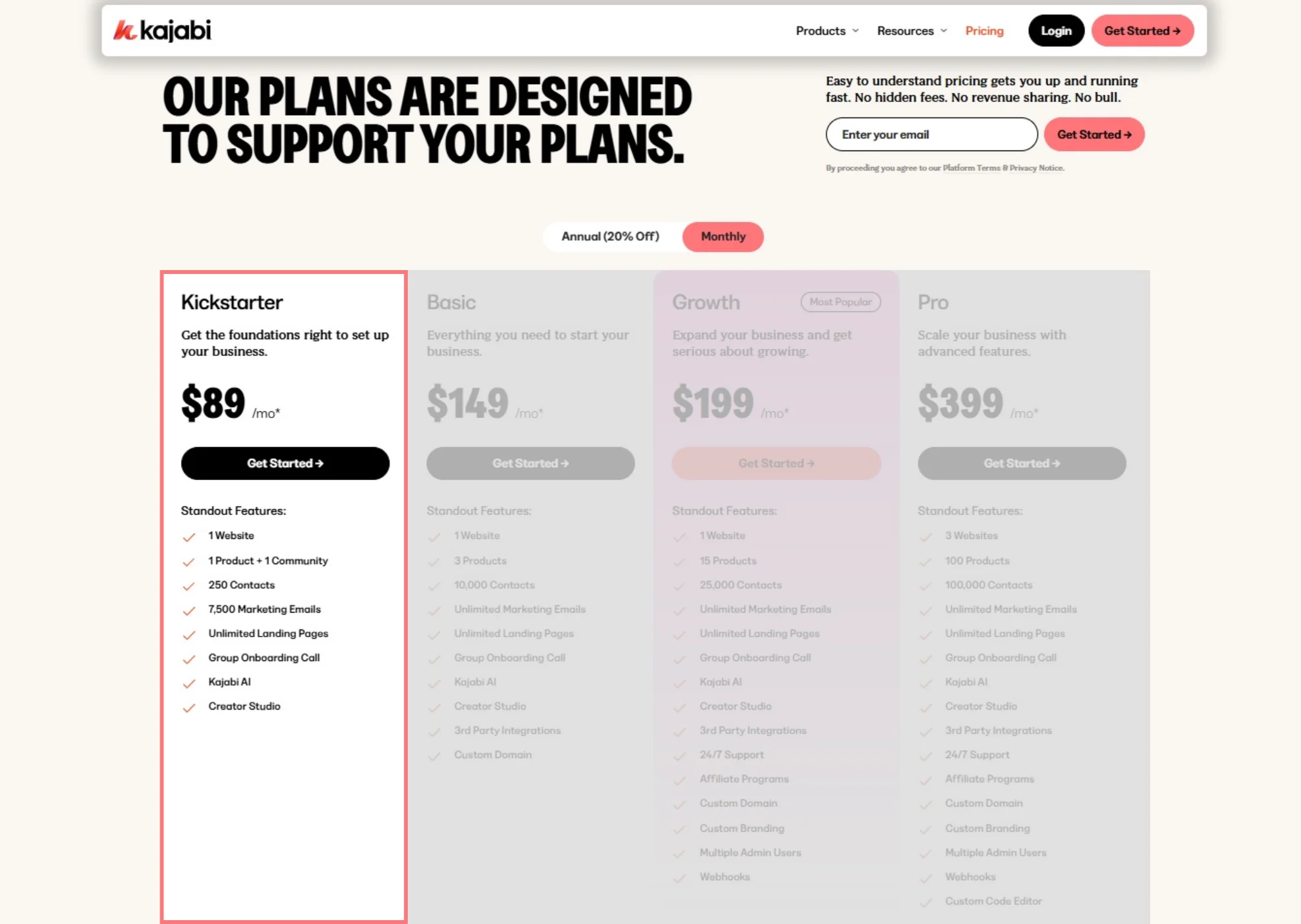
In terms of features, the Kickstarter plan includes one website, one product, and one community. Additionally, users can manage up to 250 contacts and send 7,500 marketing emails each month. While these limits are lower than the higher-tier plans, Kajabi still includes valuable tools such as unlimited landing pages, access to Kajabi AI, the Creator Studio, and a group onboarding call to help users get started quickly.
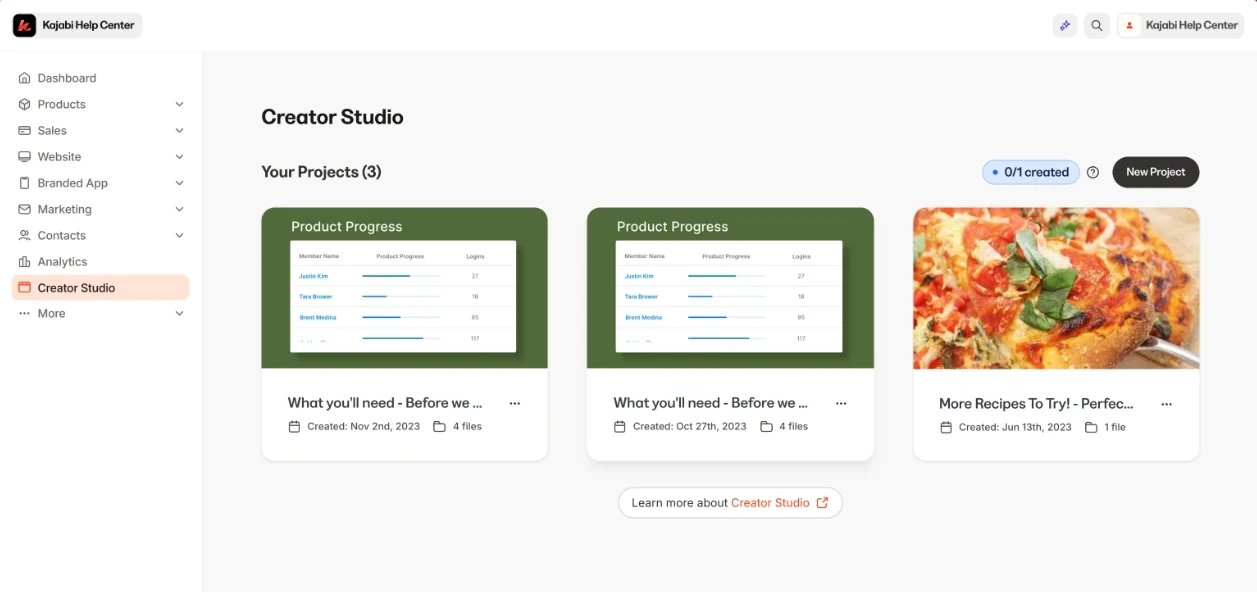
However, it’s important to note that this plan does not support third-party integrations, custom domains, or advanced features like affiliate programs and webhooks. Therefore, if you anticipate needing those tools soon, you may want to explore a higher-tier plan.
Basic: $119/month
➤ Best for: Entrepreneurs who have a growing product line and want more control over integrations and branding without jumping into higher-tier pricing just yet.
Next in line of the Kajabi pricing is the Basic plan. Pricing at $149 per month on a monthly billing cycle or $119 per month if you pay annually, this tier is a solid balance of features and affordability. If you’re looking for more freedom to launch multiple products and reach a larger audience, the Basic plan might be an ideal solution.
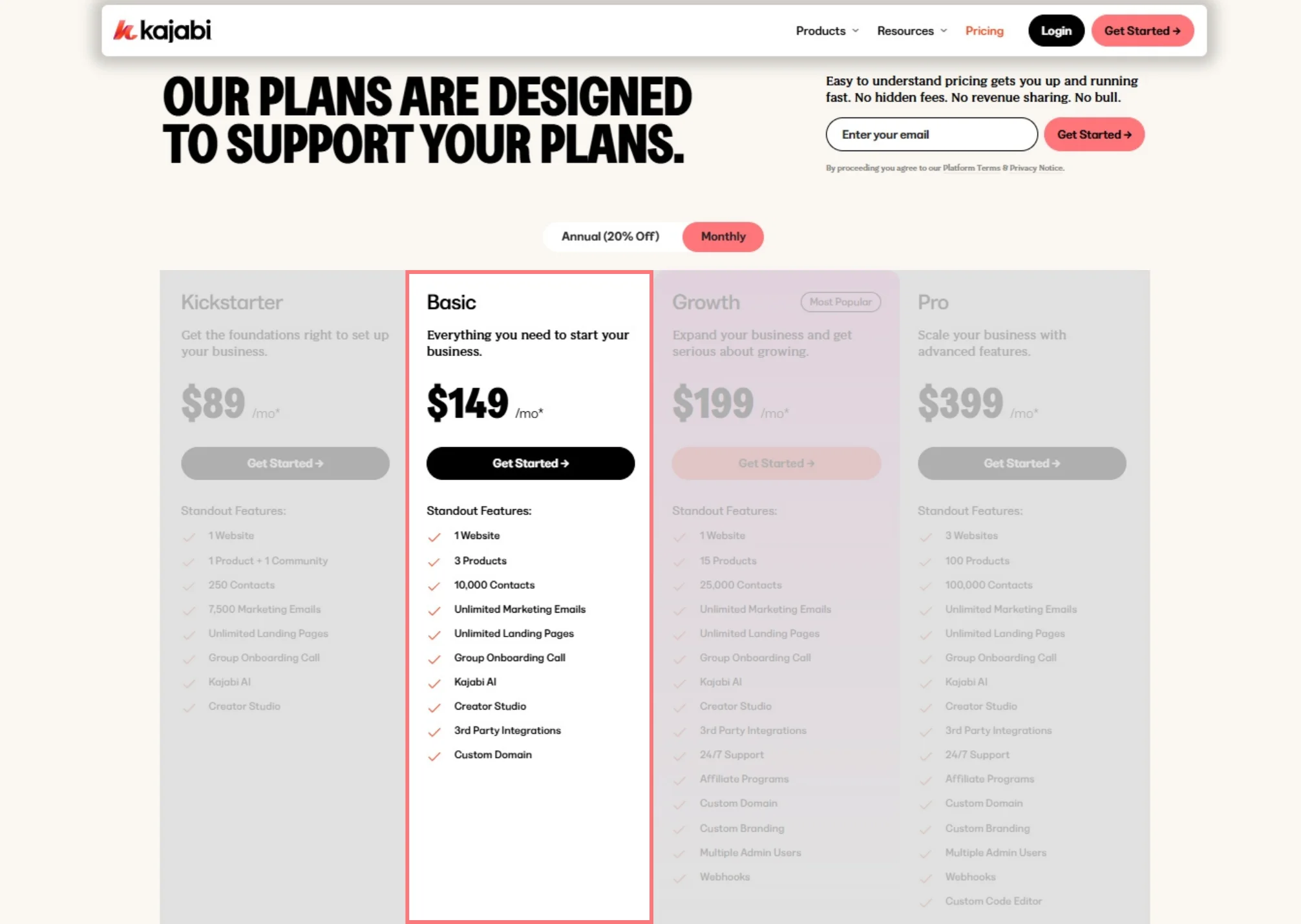
Compared to the Kickstarter plan, Basic offers more generous limits and functionality. It includes one website, up to three products, and supports 10,000 contacts. This is a notable jump that supports more diverse and scalable business models.
Additionally, while Kickstarter offers only the essentials, Basic introduces key professional features. From this tier up, users will be able to connect a custom domain to their website, which adds more flexibility and branding potential. Besides, the Basic plan also opens the door for third-party integrations, allowing businesses to harness the power of other marketing, analytics, and productivity apps for more control and automation.
Growth
➤ Best for: Growing businesses or creators who are running multiple products, managing a team, or looking to automate and expand with advanced tools.
Moving beyond the Basic plan, the Growth plan is Kajabi’s most popular option, priced at $199 per month on a monthly billing cycle or $159 per month if you pay annually. It’s designed for creators and small businesses who are ready to scale their operations, automate their workflows, and tap into more advanced features to grow faster.
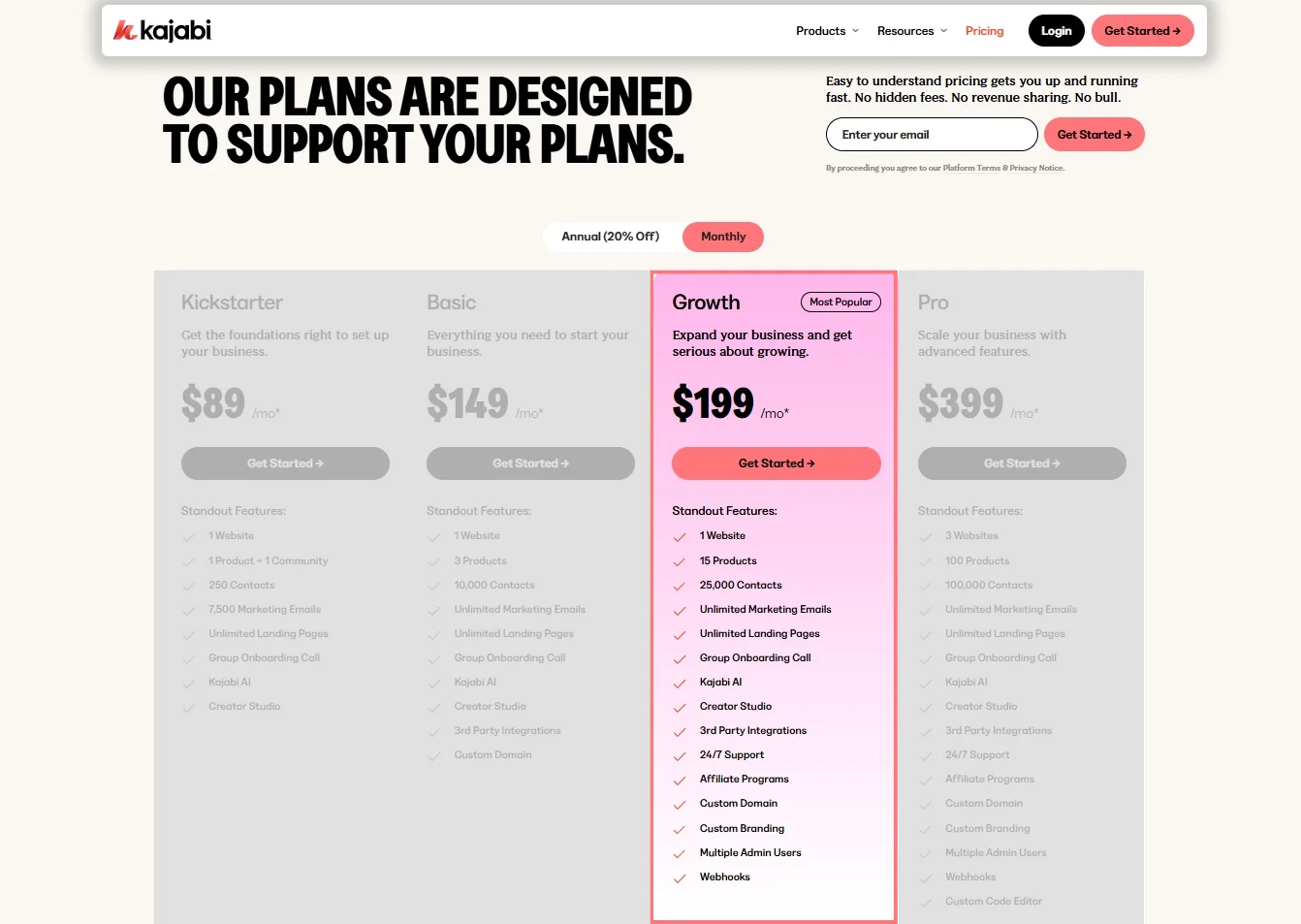
Compared to Basic, the Growth plan significantly expands your limits and capabilities. Instead of 3 products, you can now offer up to 15 products and manage 25,000 contacts, making it ideal for creators with multiple courses, communities, or digital services. Additionally, while Basic allows for just one admin user, Growth increases that to ten, making collaboration and team management much easier.
One of the biggest advantages of upgrading to Growth is access to 24/7 support, ensuring you receive help whenever you need it. You also unlock affiliate program tools, custom branding, and webhooks, none of which are available in the Basic or Kickstarter plans. These features provide you with additional opportunities to expand your business and generate passive revenue through strategic partnerships.
Pro
➤ Best for: Large-scale businesses, agencies, or tech-savvy creators who need advanced customization, multiple websites, and the ability to manage high-volume traffic and communication.
At the top of Kajabi’s pricing structure sits the Pro plan, priced at $399 per month when billed monthly or $319 per month when billed annually. This plan is tailored for established businesses, agencies, or advanced creators who need maximum flexibility, scalability, and control over their digital infrastructure.
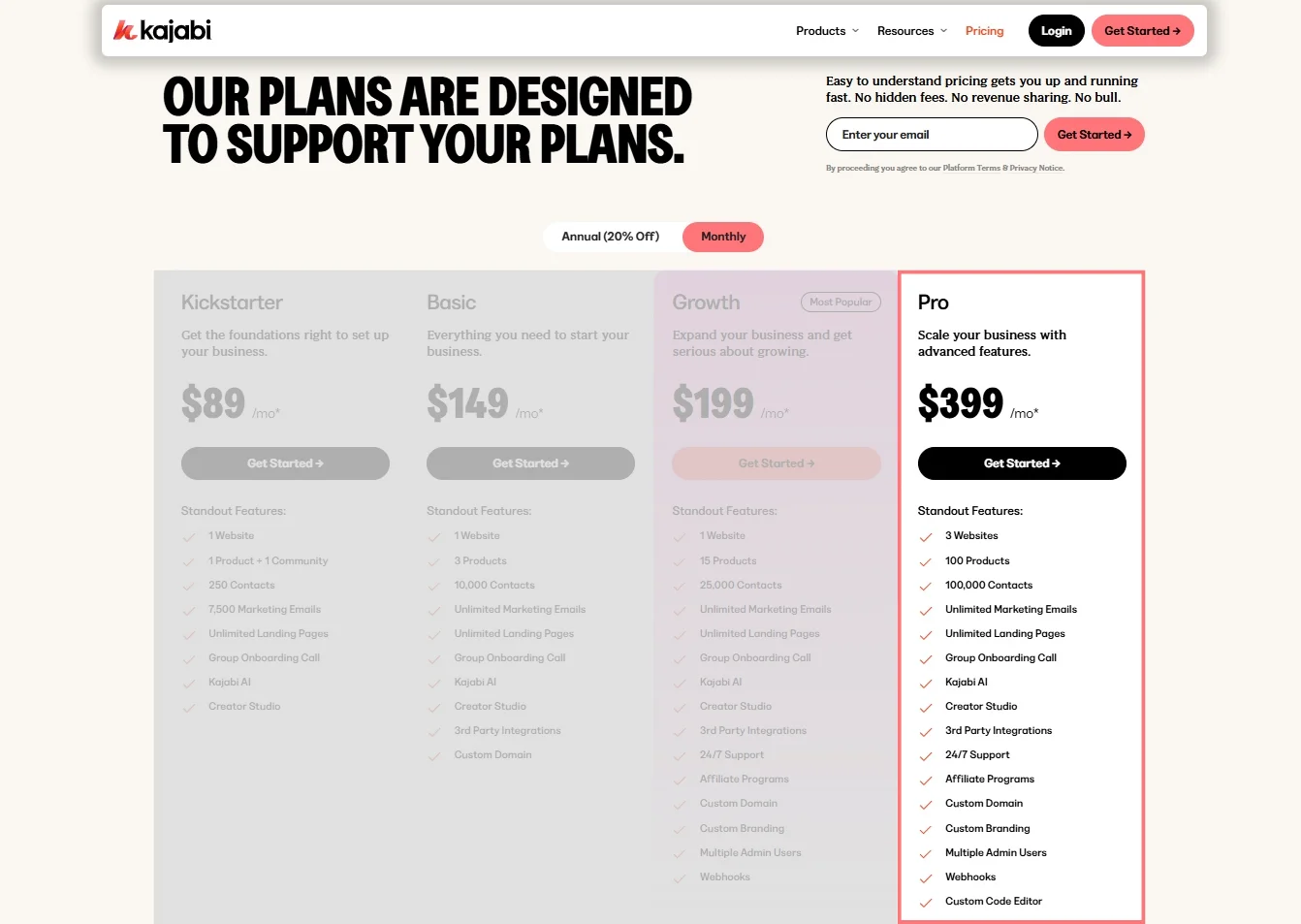
Compared to the Growth plan, Pro offers a substantial increase in capacity and customization. You can now build up to 100 products, manage 100,000 contacts, and send 2 million marketing emails per month. These expanded limits make it a great fit for enterprises or creators with large audiences and diverse offerings.
Moreover, Pro users gain access to custom code editing, enabling full control over their website's appearance and functionality. This feature is ideal for those who want to go beyond templates and deeply customize the user experience. Alongside this, users retain all features from the Growth plan, such as affiliate program management, webhooks, 24/7 support, and more.
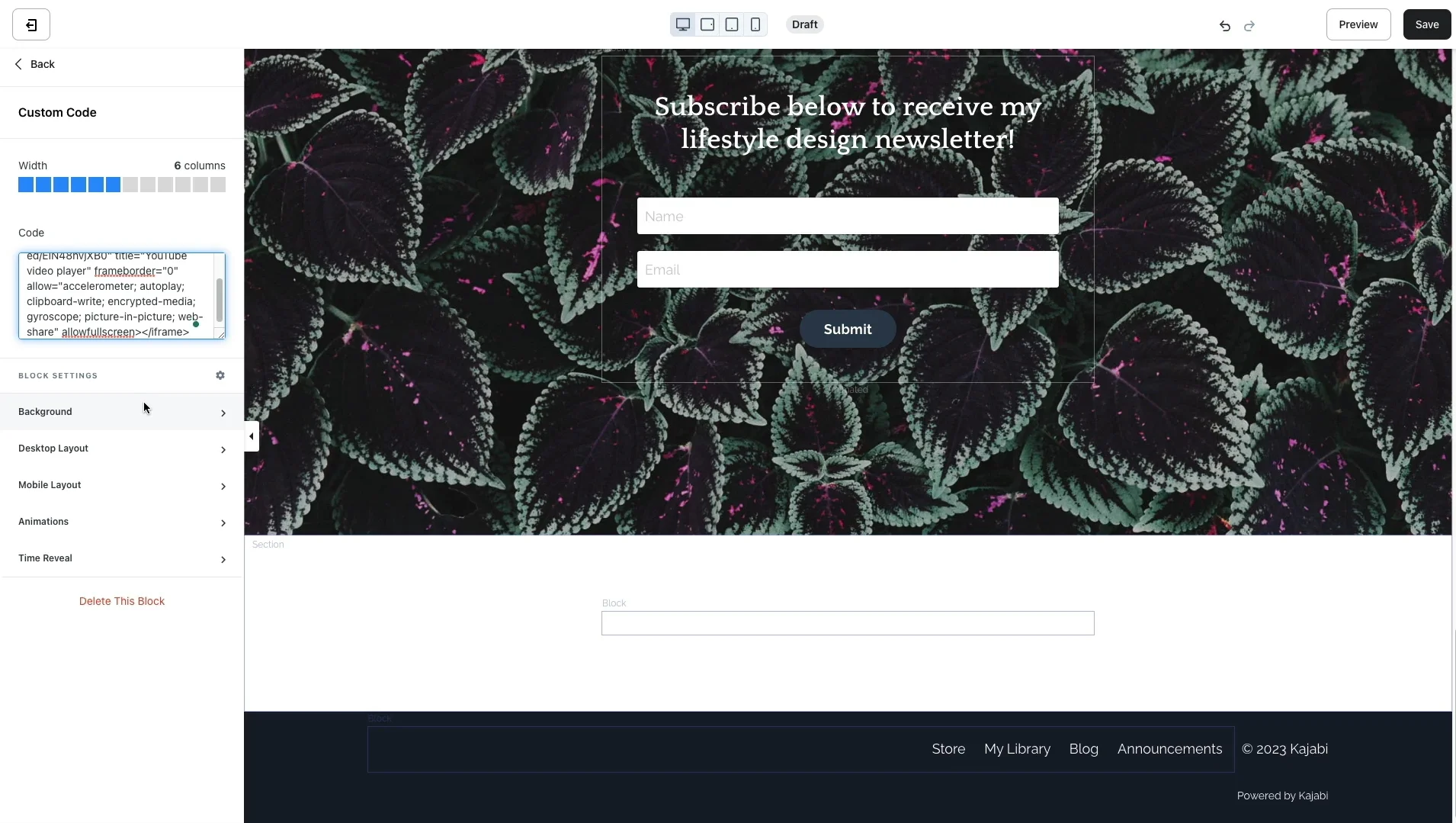
On top of that, a key upgrade exclusive to the Pro plan is the ability to run up to three websites under one account, a feature not available in any lower-tier plan. This is perfect for those managing multiple brands or business ventures.
Other Kajabi Costs You Need to Know
While Kajabi pricing plans cover the core features, there are still a few additional costs that users should be aware of. These additional expenses may not be included in your monthly subscription, but they can still affect your overall budget, particularly as your business expands.
Understanding these potential add-ons upfront will help you plan better and avoid surprises later on. From domain registration to third-party tools, let’s take a closer look at what else you might need to invest in when using Kajabi.
Domain and hosting
When it comes to launching a professional online business, having a custom domain is essential. While Kajabi includes free web hosting as part of all its plans, the domain name itself is not included and must be purchased separately.
You can buy a domain through a third-party provider like GoDaddy, Namecheap, or Google Domains, which typically costs between $5 and $50 per year. Once purchased, Kajabi allows you to easily connect your custom domain to your Kajabi site, helping you create a branded and trustworthy online presence.

It’s worth noting that SSL certificates, which keep your site secure, are included with Kajabi hosting at no extra cost. This is a great value, as some platforms charge separately for SSL or hosting upgrades.
In short, while you won’t pay extra for hosting with Kajabi, you should budget a small yearly amount for your domain if you want a branded website URL.
Transaction fees
One of Kajabi’s biggest advantages over many other platforms is that it charges no transaction fees on your sales, regardless of which pricing plan you’re on. This means you keep 100% of the revenue from your online courses and coaching sessions, minus standard payment processor fees.
However, while Kajabi doesn’t take a cut, your payment gateway will, and the amount of fees depends on your locale and payment option. For example, if you are offering Kajabi Payment, Stripe, or PayPal in the United States, you'll be charged 2.9% + $0.30 USD per transaction through credit cards.
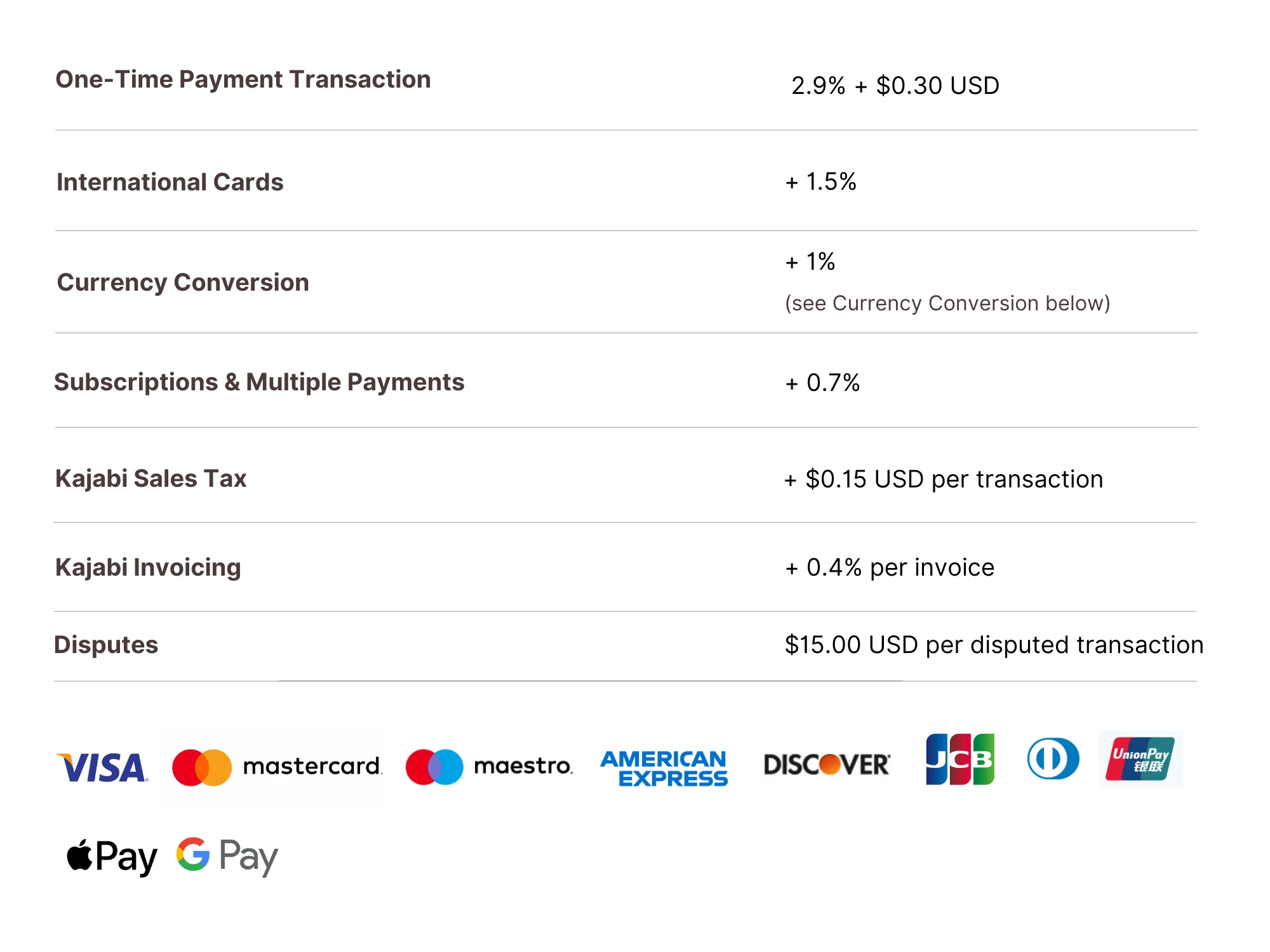
Website template
Another fee to consider when assessing Kajabi pricing is the cost of the website template, especially if you want a unique store appearance. Fortunately, Kajabi provides a selection of built-in website templates across all plans, allowing you to quickly launch a professional-looking site without needing to code. While these templates cover a range of styles tailored for course creators, coaches, and online entrepreneurs, you'll need to pay an additional fee to purchase.

To be honest, the Kajabi pricing for the website templates is not budget-friendly for everyone. The price ranges from $147 to $897 per option, which is relatively high compared to Shopify themes or Wix templates. Each template is fully customizable using Kajabi’s visual editor, making it easy to adjust colors, fonts, and layout to match your brand.
Additionally, if you want further customization, you can consider upgrading to the Pro plan to unlock the custom code editor, which is a powerful tool to add personal touches to your website. Whether you’re creating a homepage, sales page, or thank-you page, you can start with a polished design and tweak it as needed.
Integrations
Kajabi is built to be an all-in-one platform, but many users still rely on additional tools to run their business efficiently, and this is another cost you need to consider when assessing Kajabi pricing. Fortunately, Kajabi offers a variety of integrations to help you connect your favorite apps and services, many of which are available at no extra cost.
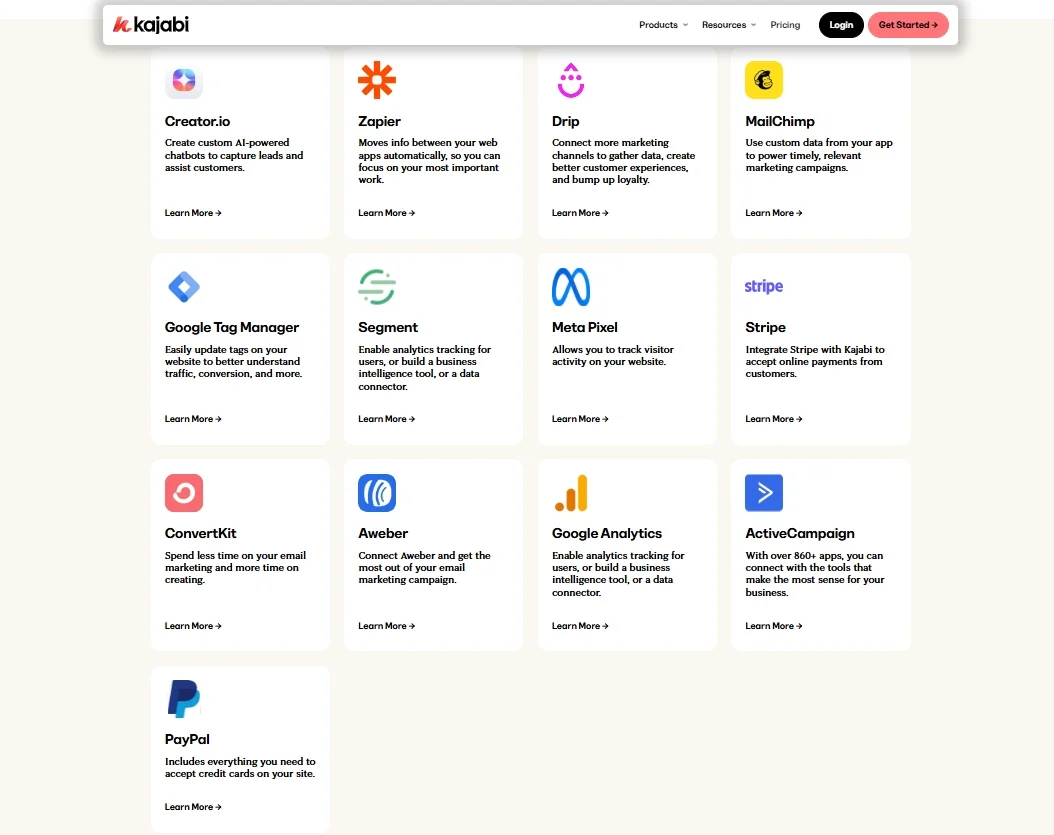
Out of the box, Kajabi integrates with popular platforms like Stripe, PayPal, Google Analytics, and Facebook Pixel. These built-in connections allow you to process payments, track performance, and automate tasks with ease, especially with no fee to integrate.
However, it's important to know that some integrations may require separate subscriptions. For example, if you use email marketing tools, CRM systems, or advanced automation platforms via Zapier, you’ll need to pay for those services directly. Additionally, while Kajabi supports integrations through Zapier, some complex workflows may need premium Zapier accounts, which range from $19 to $69 per month.
Kajabi Pricing vs Competitors
In this section, we’ll compare Kajabi pricing to that of top competitors like Wix and Squarespace. By breaking down monthly costs, transaction fees, and additional expenses, you’ll get a clearer picture of which platform offers the best value based on your goals and budget.
Criteria | Kajabi | Wix | Squarespace |
Monthly subscription | Ranges from $89 to $399 per month | Ranges from $17 to $159 per month | Ranges from $25 to $139 per month |
Domain & hosting fee | Hosting included Domain costs up to $50 per month | Hosting included Free domain for 1 year on annual plans, then $14.95/year | Hosting included Free custom domain for 1 year on annual plans, then $20/year. |
Transaction fee | No transaction fee Payment processing fee: 2.9% + ¢30 per purchase | No transaction fee Payment processing fee: Up to 3.49% + 0.49 USD | 3% transaction fee on Business plan; 0% on Commerce plans |
Template fee | Ranges from $149 to $897 per option | Free templates included in all tiers | Free templates included in all tiers |
Integration fee | Integration via Zapier might require a paid plan | Wix App Market offers both free and paid apps | Squarespace Extensions might require subscription |
Kajabi Pricing – FAQs
Is Kajabi free?
Kajabi is not a free platform, but it does offer a 14-day free trial that allows new users to explore its features and build their first product or funnel. During the trial, you can test Kajabi’s tools without needing to enter payment details upfront. After the trial ends, you’ll need to choose a paid plan to continue using the platform.
How much does Kajabi cost?
Kajabi’s pricing starts at $89/month with the Kickstarter plan. Other tiers include Basic ($149/month), Growth ($199/month), and Pro ($399/month). Each plan includes core features like product creation, email marketing, and website hosting, but the limits on products, contacts, and advanced tools increase as you go up in tiers.
Is Kajabi worth the price?
For many creators and small businesses, Kajabi is absolutely worth the investment, especially if you're looking for an all-in-one platform that replaces multiple tools. With built-in course hosting, email marketing, landing pages, and automation, it can save time, reduce tech headaches, and offer better integration across your business. While the monthly cost is higher than some alternatives, the value often outweighs the price if you're actively selling and scaling.
How many courses can you have on Kajabi?
The number of courses (or "products") you can create depends on your plan:
- Kickstarter: 1 product
- Basic: Up to 3 products
- Growth: Up to 15 products
- Pro: Up to 100 products
These limits include courses, memberships, and digital downloads. If you need to offer multiple learning experiences, upgrading your plan will give you the space to scale.
Final Words
And that brings us to the end of our Kajabi pricing breakdown. To be honest, while Kajabi pricing might be higher than some competitors, it delivers a complete package that eliminates the need for multiple subscriptions across tools like course hosting, email marketing, landing page builders, and automation. For many users, this convenience and integration make the platform well worth the investment.
If you want more expert tips and insights on this platform, please don't hesitate to check out other articles on our LitExtension blog.

